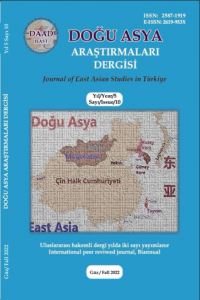Polonya ve Japonya: Hayali Topluluklar?
Japonya ve Polonya hakkında mevcut literature göre 19. Yüzyıl her iki ülkenin milliyetçiliğinin tanımlanmasında bir dönüm noktası olmuştur. Polonya, milliyetçiliğini büyük sorunların olduğu dönemlerde; 1795 yılında bağımsızlığını kaybettiğinde, “Ulusların Baharı” döneminde ve son olarak da 1918 yılındaki özgürleşme sürecinde şekillendirmiştir. Japonya’da ise devrimci değişiklikler sırasıyla siyasetçiler ve toplumun merkezini etkileyecek biçimde olmuştur. Şogunluk sistemi kaldırılmış ve imparator kuvvetli Batılılaşma ihtiyacı bulunduğu gerekçesiyle tekrar koltuğunu geri almıştır. Bu çalışma literatürde genişçe yer bulan ve aynı zamanda moderniteyi Batılı ulusların gelişmesinde merkeze alan Batı merkezli uluslaşma tartışmasından yeni kurulmuş ulusların (Japonya ve Polonya) görülmemiş benzerlikteki büyümeleri alanına taşımaya çalışacaktır.
Anahtar Kelimeler:
Topluluklar, Japonya, Polonya, Ulus, Tabandan Kalkınma
Poland and Japan: The Imagined Communities?
According to historical literature about Japan and Poland, the XIX Century was a turning point in defining those two countries –– nationhood. Poland was shaping its nationhood in the times of great strife the loss of independence in 1795, the period of “Spring of the Nations” and finally liberation in 1918. In Japan, respectively revolutionary changes had occurred that impacted the core of polity and society. The Shogunate system had been abolished, and in a political vacuum, the Emperor regained seat of his power with the strong notion and necessity for “Westernization”. This paper will attempt to shift the discussion from the Western-centric debate of the nation; that is undoubtedly vast in literature and at the same time accenting modernity as the motor of western nations evolution; into the territory of newly established nations (Japan and Poland) and their unprecedented, corresponding growth.
Keywords:
Communities, Japan, Poland, Nation, Grassroot development,
___
- ANDERSON, B. (2016). Imagined Communities: Reflections On The Origin And Spread Of Nationalism. London: Verso. BURNS, S. L. (2003). Before The Nation: Kokugaku And The Imaging Of Community İn Early Modern Japan. London: Duke University Press. DAVİES, N. (2006). God's Playground: A History Of Poland. Krakow: Znak. FARKAS, I. (2013). The Japanese Nation Building İn European Comparison. Acta Asiatica, page: 1-28. HUNTİNGTON, S. (1993). The Clash Of Civilizations? Foreign Affairs, Page: 22-49. Retrieved From Http://Online.Sfsu.Edu/Mroozbeh/Class/H-607-Pdfs/S.Huntington-Clash.Pdf ; Accessed: 12.05.2018. HUNTİNGTON, S. (1996). The Clash Of Civilizations And The Remaking Of World Order. New York: Simon & Schuster. JANİON, M. (2003). Poland Between The West And East. Retrieved From Digital Repository Of Science Institutes: Http://Rcin.Org.Pl/Dlibra/Doccontent?İd=54378; Accessed: 30.04.2018. KERN, S. (2017, July 2). Europe's Migrant Crisis: Views From Central Europe. Retrieved From Https://Www.Gatestoneinstitute.Org/10610/Migrant-Crisis-Central-Europe; Accessed: 29.04.2018. KLOCZOWSKİ, J. (1984). Europa Slowianska W Xiv - Xv Wieku. Warsaw: P.I.W. KURENDA, M. (1999). Polityka Repatriacyjna Polski. Zarys Ewolucji Rozwiazan Instytucjonalno-Prawnych W Latach 1918 - 1998. Warsaw: Bureau Of Research Of The Chancellery Of The Sejm. MACH, Z. (2014). Polish National Culture An İts Shifiting Centres. Retrieved From Humanity İn Action: Https://Www.Humanityinaction.Org/Files/278-Polish_National_Culture_And_İts_Shifting_Centres.Pdf ; Accessed: 26.04.2018. MCCLAİN, J. L. (2002). Japan, A Modern History. New York: W. W. Norton & Company. NATO. (2017, August 27). Www.Nato.İnt. Retrieved From Https://Www.Nato.İnt/Cps/En/Natohq/News_146512.Htm?Selectedlocale=En ; Accessed: 26.04.2018. NEARY, I. (2002). The State And Politics İn Japan. Polity. YAKUWA, T. (2003). Literacy In Tokugawa Japan. The Japanese Journal Of Education Research, Page: 524-535. Doi:Https://Doi.Org/10.11555/Kyoiku1932.70.524; Accessed: 26.05.2018.
- ISSN: 2587-1919
- Yayın Aralığı: Yılda 2 Sayı
- Başlangıç: 2015
- Yayıncı: Abdürreşit Celil KARLUK
Sayıdaki Diğer Makaleler
Polonya ve Japonya: Hayali Topluluklar?
Krzysztof Leszek MĘDRZYCKI, Krzysztof Leszek MĘDRZYCKI
Nureddin İZBASAR, Nureddin İZBASAR
Bölge Uzmanı ile Söyleşi / Interview with Regional Expert Bilinenin Ötesinde Bir Ülke: Japonya
Ali Merhan DÜNDAR, Ali Merhan DÜNDAR
